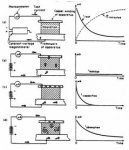knoppdude
Senior Member
- Location
- Sacramento,ca
Does anyone have experience using Simpsons 1000v insulation tester, and what is your opinion of it? I am looking to buy one of these, or the greenlee hand crank model. Any advice is appreciated.
Thanks Zog, the voltages would be 250-1000, and the tester would be used at least once daily, testing 480 volt motor branch circuits. What would you recommend as a better tester than these two?
, what is DAR and PI testing?

Thank you for the replies. Brian John, Fluke does seem to be the best choice, and they sell devices that can be used to determine the Polarization Index, and DAR. Plus they seem to have a more available supplier network, and the price is not overwhelming. Zog, you have opened up a whole new world of insulation testing for me. I can't quite make out the jpeg, but have found some information on the internet. I really had no idea about insulation testing, and usually only caught existing insulation failures, either motors or branch circuits. Now I see that the condition of insulation can be measured over time, and deterioration rates determined. I feel like I just found a thousand dollars in the attic.
When you megger something you are not really measuring resistance, you are measuring current (And calculating resistance) There are 3 currents being measured (Important to understand you are measuring current, no such thing as an ohmeter) this is very important to understand when testing inductive equipment.
(View attachment before reading on)View attachment 5482
When a high DC voltage is first applied the total current (a) consists of three current components;
1. Leakage current
2. Capacitance charging current
3. Absorption current
Conduction/Leakage Current (b) - This current passes through the surface of the insulation. The magnitude of current flow depends on the resistance of the insulation. Surface leakage is usually not a problem because it can be eliminated through external cleaning.
Capacitive Current (c) - The insulating specimen appears, ideally, as a capacitor. As a DC voltage is applied to a capacitor initial charging current flows until the voltage drop across the component equals the source voltage. As the capacitor charges, its charging current decreases to a minimum. This is called its steady-state value.
Dielectric Absorption Current (d) - This current also appears at the initial application of test voltage the same as capacitance current. This current is required to polarize the insulating medium. In other words it is energy absorbed by the insulating system.
To seperate these different qualities of an insulating system you can use the time they take to decay (As you can see on the attachment). Since the currents are decaying the indicated resistance reading on your display will go higher.
When you test, record the values at 30 seconds, 1 minute, and 10 minutes. The 1 mniute reading divided by the 30 second reading is called your Dielectric Absorbtion Ratio (DAR). The 10 minute reading divided by the 1 minute reading is your Polarization Index (PI). The values of these ratios can be used to determine the condition of the entire insulating system and allow you to do a condition assement of your assets.
Understanding these qualities is important, I have seen many people meg a motor for a few seconds and say it is good, they just did not know what they were reading.
Another key thing is properly correcting your readings for temature. Most equipment is corrected to 20C, motors and generators usually to 40C. Temp makes a huge difference!!
The point of PI/DAR tests is to track over time from new possibly, so if the 1507 won't run the test, what good is it? Sometimes the 1507 will run the test if 1000V which maybe be higher than required. There are other units like from AEMC that will run a PI/DAR test at 500V where a 1507 fails to even at 1000V. What does that have to say about the 1507's specs?I just bought the Fluke 1507, and it seems satisfactory for what work I will be doing. I also printed out and am reading through "A stitch in time", free online, and very worth reading. It explains more about insulation testing than I ever understood. As this model has a 10 G Ohm range, it will read error if the insulation is in good shape on the PI and DAR tests. I called the Fluke people, and they said that all this means is just that, that the insulation is in very good shape, and outside the range of the meter to measure. So far I am happy with it, and found some problems in the motor branch circuits I tested, and confirmed that others were good. Found one 300HP crusher motor that was in such bad shape, that it caused the meter output voltage to drop during the test. I got such a low PI score that the breaker will probably trip on startup. Fortunately, it is temporarily out of service. Thanks for all of the responses.

